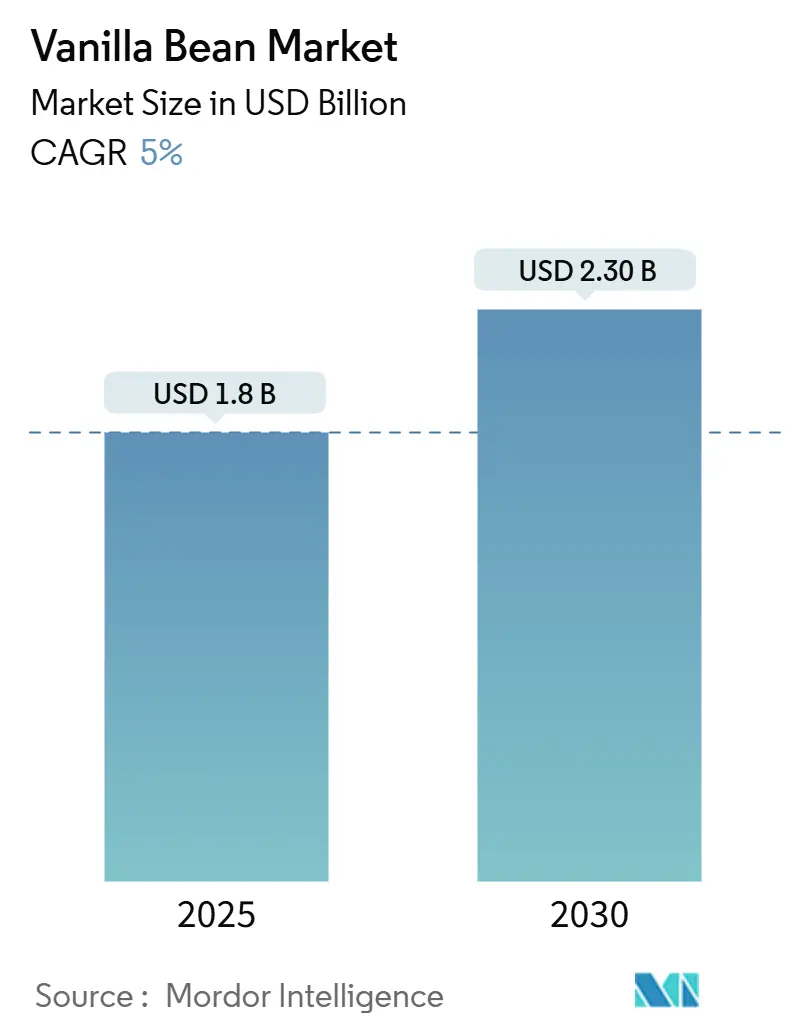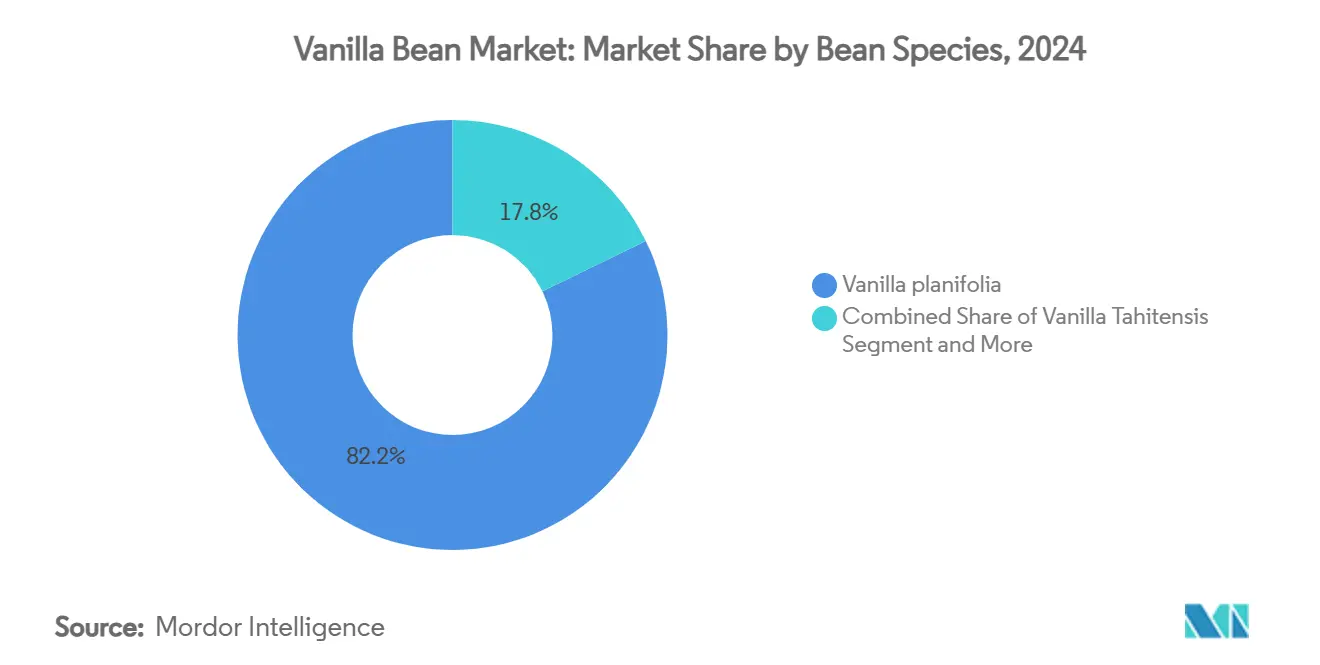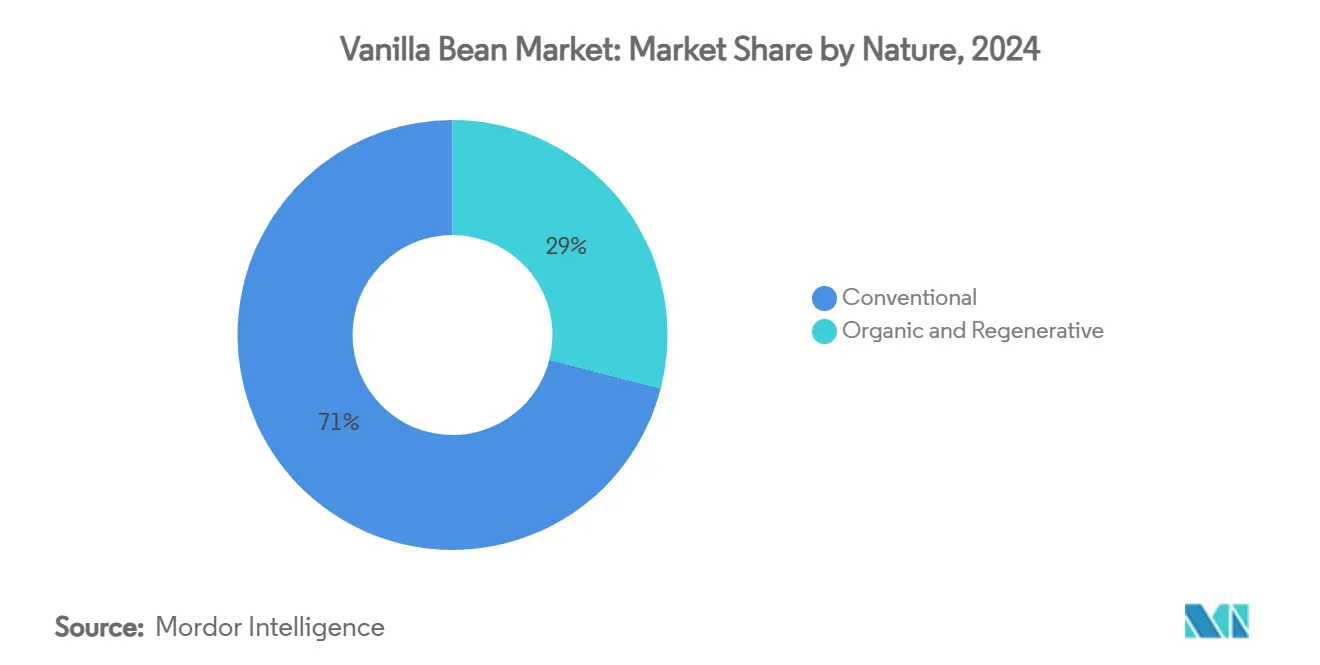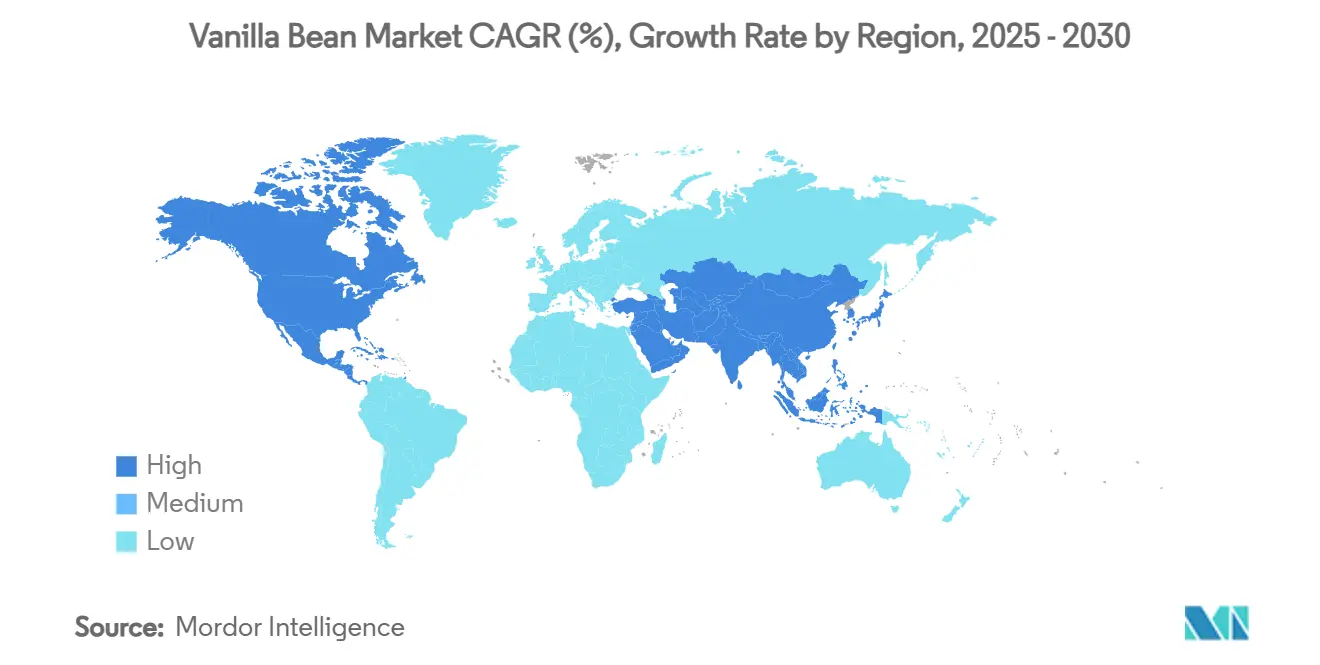Vanilla Bean Market Size and Share

Vanilla Bean Market Analysis by Mordor Intelligence
The vanilla bean market size is valued at USD 1.8 billion in 2025 and is forecast to reach USD 2.3 billion by 2030, advancing at a 5% CAGR. Robust demand for natural flavor solutions, premium pricing power, and the sector’s pivot to certified sustainable supply underpin this steady expansion. Madagascar continues to set benchmark prices, but Indonesia’s competitively priced beans and the rise of controlled-environment farming are broadening global supply options. At the same time, synthetic and bio-engineered vanillin technologies intensify price competition, forcing growers and processors to double down on traceability, carbon-smart agroforestry, and genetic-diversity programs to defend their value proposition.
Key Report Takeaways
- By bean species, Vanilla planifolia led with 82.2% of vanilla bean market share in 2024, and Vanilla tahitensis is projected to grow at a 7.8% CAGR through 2030.
- By nature, conventional beans accounted for 71% of the vanilla bean market size in 2024, while organic and regenerative segments are expanding at an 8.2% CAGR to 2030.
- By end-use application, food and beverage processing retained 68% of the vanilla bean market size in 2024, and nutraceutical use is advancing at a 9.3% CAGR through 2030.
- By geography, Asia-Pacific captured 54% of the vanilla bean market share in 2024, and North America shows the fastest CAGR at 6.4% to 2030.
Global Vanilla Bean Market Trends and Insights
Drivers Impact Analysis
| Driver | (~) % Impact on CAGR Forecast | Geographic Relevance | Impact Timeline |
|---|---|---|---|
| Premiumization of natural flavours in global food industry | +1.2% | Global, strongest in North America and Europe | Medium term (2-4 years) |
| Growing demand from nutraceutical and cosmeceutical processors | +0.8% | North America, Europe, Asia-Pacific emerging | Long term (≥ 4 years) |
| Shift toward organic and regenerative vanilla farming | +0.6% | Global, led by Madagascar and Indonesia | Long term (≥ 4 years) |
| Rising traceability mandates by confectionery majors | +0.4% | Global, driven by EU and US regulations | Medium term (2-4 years) |
| Carbon-credit revenue streams for agro-forestry vanilla farms | +0.3% | Madagascar, Uganda, Indonesia | Long term (≥ 4 years) |
| Expansion of controlled-environment vanilla cultivation projects | +0.2% | North America, Europe, Middle East | Long term (≥ 4 years) |
| Source: Mordor Intelligence | |||
Premiumization of Natural Flavours in the Global Food Industry
Natural vanilla retains its aura of authenticity and commands unit prices of USD 1,200-4,000 per kg despite synthetic substitutes costing USD 10–20. Ice cream producers, a USD 37.1 billion category in 2025, allocate higher ingredient budgets to ensure clean-label claims, while artisanal bakeries leverage vanilla’s aroma to differentiate gourmet lines. As premium cues widen the willingness-to-pay gap, volume remains sensitive to macroeconomic swings, yet evidence suggests consumers trade down on package size rather than switching to synthetic vanillin, preserving value for the vanilla bean market.
Growing Demand from Nutraceutical and Cosmeceutical Processors
Bioactive research shows vanillin exhibits antibacterial efficacy against multidrug-resistant strains at 1.25–2.5 mg/mL and delivers potent antioxidant action[1]Source: Mdpi Journal Editors, “Antioxidant and Antimicrobial Activity of Vanillin,” mdpi.com. Nutraceutical formulators now incorporate vanilla extracts in immune-support gummies and ready-to-drink functional beverages, unlocking higher per-kg profit than traditional flavor uses. This diversification into value-added end markets cushions growers against cyclical food demand and boosts average selling prices for solvent-free, high-purity extracts.
Shift Toward Organic and Regenerative Vanilla Farming
Organic certification delivers 20-30% price premiums and is pivotal to meeting EU and US retailer sustainability scorecards. Agroforestry trials in Madagascar demonstrate that intercropping vanilla with endemic trees can raise carbon stocks while stabilizing yields under hotter, more variable climatic conditions. Forward-looking brands have begun referencing regenerative vanilla on packaging, created consumer-facing QR codes for plot-level stories, and negotiated multi-year offtake contracts that guarantee smallholders price floors above New York vanilla bean market averages.
Rising Traceability Mandates by Confectionery Majors
Global chocolate manufacturers have accelerated blockchain-backed traceability systems that log every hand-pollinated pod through export. Barry Callebaut’s Forever Chocolate program targets 100% sustainable ingredients by 2025 and now requires farm GPS data for vanilla in the same manner as for cocoa[2]Source: Barry Callebaut AG, “Forever Chocolate Progress Report 2024,” barry-callebaut.com. As confectionery groups link executive remuneration to sourcing KPIs, buyers refuse beans lacking digital origin records, lifting compliance costs yet raising entry barriers for opportunistic traders. Traceability also underpins living-income price mechanisms that stabilize smallholder earnings, indirectly enhancing supply stability for the vanilla bean market.
Restraints Impact Analysis
| Restraint | (~) % Impact on CAGR Forecast | Geographic Relevance | Impact Timeline |
|---|---|---|---|
| Price volatility linked to cyclone risk in Madagascar | -0.8% | Global, concentrated impact on Madagascar | Short term (≤ 2 years) |
| Surging availability of synthetic and bio-engineered vanillin | -0.6% | Global, strongest in price-sensitive markets | Medium term (2-4 years) |
| Organized crime and bean theft undermining supply stability | -0.4% | Madagascar, emerging in Uganda and Indonesia | Short term (≤ 2 years) |
| Limited genetic diversity heightening disease susceptibility | -0.3% | Global production regions | Long term (≥ 4 years) |
| Source: Mordor Intelligence | |||
Price Volatility Linked to Cyclone Risk in Madagascar
Historical satellite data show storm frequency and intensity rising in the western Indian Ocean, raising probabilistic risk for each flowering season. Heavy concentration of global supply means one extreme event reverberates across the vanilla bean market within weeks, compelling manufacturers to hold higher inventories and ensure shipments in transit. Although controlled-environment farms in the United States and Denmark supply niche tonnage, they remain several magnitudes too small to neutralize cyclone-induced shocks.
Surging Availability of Synthetic and Bio-engineered Vanillin
Fermentation platforms led by Evolva now produce yeast-derived vanillin that regulators may classify as “natural,” eroding the unique selling proposition of bean extracts. Spero Renewables has piloted corn-fiber-to-vanillin conversion, targeting a sub-USD 130 per kg cost of goods less than one-tenth of Grade 1 bean prices. Synthetic vanillin already accounts for 88% of the total vanillin supply. If bio-engineered volumes scale, the vanilla bean market could lose share in mass-market food categories, though premium niche demand is projected to persist for authentic pods with terroir-driven flavor nuances.
Segment Analysis
By Bean Species: Planifolia Dominance Drives Market Stability
Vanilla planifolia held 82.2% of the vanilla bean market share in 2024, owing to its high 1.21%-3.50% vanillin concentration and broad agronomic knowledge base among Madagascan, Indonesian, and Ugandan farmers. Fusarium-wilt pressure exposed the vulnerability of monoclonal plantations. Recent mapping identified 20 loci linked to resistance, enabling breeders to cross-select hardier clones[3]Source: American Phytopathological Society, “Genetic Loci for Fusarium Resistance in Vanilla,” apsnet.org. Novel crosses between planifolia and tahitensis are also under laboratory evaluation.
Vanilla tahitensis, with its floral-fruity notes, is growing at 7.8% CAGR, catering to pastry chefs and gelato makers in the French premium segment. Novel crosses between planifolia and tahitensis are also under laboratory evaluation. Smallholder clusters in Papua New Guinea, Vanuatu, and India cultivate Vanilla pompona and indigenous varieties that command boutique demand streams, but limited extension support and lack of curing infrastructure hinder volume ramp-up. Maintaining biodiversity across these minor species offers a hedge against disease outbreaks that could otherwise cause systemic losses in the vanilla bean market.

Note: Segment shares of all individual segments available upon report purchase
By End-Use Application: Diversification Beyond Traditional Food Markets
Food and beverage processing absorbed 68% of global volume in 2024, led by dairy, bakery, and confectionery. Within that base, clean-label, reduced-sugar launches rely on vanilla’s aromatic complexity to mask stevia and monk-fruit aftertastes. Pharmaceutical and nutraceutical firms used 2,640 metric tons of extract equivalents in 2024, but demand is climbing 9.3% CAGR as vanillin’s anti-microbial profile gains regulatory acceptance for over-the-counter lozenges[4]Source: Mdpi Journal Editors, “Antioxidant and Antimicrobial Activity of Vanillin,” mdpi.com.
By Nature: Organic Certification Reshapes Value Propositions
Conventional beans account for 71% of the 2024 volume, yet certified organic and regenerative lots fetch USD 280–350 per kg, 20–30% over standard beans. The vanilla bean market size for certified organic products reached USD 0.52 billion in 2025 and is forecast to expand at 8.2% CAGR. Agroforestry projects co-ordinated by Frontier Co-op are not only boosting yields but also demonstrating 35% higher biodiversity scores than monoculture benchmarks.

Geography Analysis
Asia-Pacific led the vanilla bean market in 2024 with a 54% share of trade and consumption. Indonesia sold Grade 2 beans at USD 140–200 per kg, allowing regional processors to offer competitively priced natural vanilla ice cream that undercuts imported Madagascan formulations. China and India, with expanding middle classes, integrate vanilla in Western-style bakery chains, ready-to-drink coffee, and nutraceutical sachets, reinforcing volume growth. Papua New Guinea’s 491 metric tons output in 2022 marked an all-time high, yet infrastructural gaps, including limited curing hubs and informal trade routes, continue to cap export upside.
North America is the fastest-growing region, projected at a 6.4% CAGR. The United States imported 1,050 metric tons of cured beans in 2024, including first domestic harvests from Florida greenhouse projects that achieved 20% shorter growth cycles than field crops. Controlled-environment farms also align with USDA incentives for specialty-crop diversification, encouraging further acreage additions inside high-tech greenhouses.
Europe vanilla bean market is dominated by France, Germany, and the Netherlands. Importers have tightened supplier scorecards to include deforestation and child-labor metrics, pushing African and Pacific exporters to adopt digital traceability solutions. The region’s mature yet premium-oriented consumer base underpins stable demand even during economic slowdowns, offering a reliable floor for global prices.

Recent Industry Developments
- May 2025: Indonesia’s organic vanilla maintains strong US foothold despite new tariffs, leveraging certified supply chains to hold premium segment share.
- November 2024: Madagascar vanilla exports reach 4,300 metric tons in the first seven months of 2024, sparking price-softening concerns.
- June 2024: Papua New Guinea retains 50% vanilla export flow to Indonesia despite diversification efforts.
Research Methodology Framework and Report Scope
Market Definitions and Key Coverage
Our study defines the vanilla bean market as the yearly global trade value of cured, whole pods from the Vanilla orchid that are shipped in bulk for processing or direct culinary use. Production volumes are mapped through harmonized commodity codes, and transaction values are gathered at the importer and wholesaler level.
Scope Exclusion: We exclude flavored derivatives such as extracts, powders, and synthesized vanillin.
Segmentation Overview
- By Bean Species (Value)
- Vanilla planifolia
- Vanilla tahitensis
- Others
- By Nature (Value)
- Conventional
- Organic and Regenerative
- By End-Use Application (Value)
- Food and Beverage Processing
- Fragrance and Personal Care
- Pharmaceuticals and Nutraceuticals
- Others (Animal Feed, etc.)
- By Geography (Volume and Value)
- North America
- United States
- Canada
- Mexico
- South America
- Brazil
- Peru
- Europe
- Germany
- United Kingdom
- France
- Spain
- Russia
- Asia-Pacific
- China
- India
- Japan
- Australia
- Indonesia
- Middle East
- Saudi Arabia
- UAE
- Turkey
- Africa
- South Africa
- Uganda
- Tanzania
- Madagascar
- North America
Detailed Research Methodology and Data Validation
Primary Research
Mordor analysts speak with growers in Sava, exporters in Uganda, artisan ice-cream formulators in North America, and bulk buyers across Europe. These discussions verify yield assumptions, typical cured-bean prices, and the pace of organic certification; insights that desk research alone cannot deliver.
Desk Research
We begin with crop statistics from the FAO, export filings on the ITC Trade Map, and customs shipment logs accessed through Volza. Context is strengthened with UN Comtrade price series, CBI buyer guides, and regulatory notes from the EU Novel Food Catalog. Company filings, investor decks, and respected agricultural press help us track supply shocks after cyclones in Madagascar. D&B Hoovers and Dow Jones Factiva are then queried to benchmark processor revenues against declared export receipts, revealing early anomalies that steer the next interview wave. The sources listed are illustrative; many additional public datasets inform our full model.
Market-Sizing & Forecasting
A top-down construct converts FAO tonnage into trade value through triangulated average selling prices, which are then reconciled with sampled exporter invoices for 2024-2025. Limited bottom-up supplier roll-ups around key curing cooperatives act as guardrails. Key variables like cyclone frequency indices, organic acreage, premium ice-cream output, unit import duties, and synthetic vanillin penetration feed a multivariate regression that projects demand to 2030. Gaps in bottom-up evidence are bridged with region-specific price elasticities drawn from survey feedback.
Data Validation & Update Cycle
Outputs pass two analyst reviews, outlier checks against vanilla-extract price curves, and senior sign-off. We refresh the model annually, reopening it sooner if export rules or extreme weather alter fundamentals.
Why Mordor's Vanilla Bean Baseline Commands Reliability
Published estimates often diverge because firms adopt different product scopes, currency years, and update rhythms.
Key gap drivers include mixing extracts with pods, applying retail rather than wholesale prices, and shorter refresh cadences that miss recent duty hikes. Our model fixes scope to cured pods only and is re-benchmarked after each harvest, yielding steadier numbers.
Benchmark comparison
| Market Size | Anonymized source | Primary gap driver |
|---|---|---|
| USD 1.8 Bn (2025) | Mordor Intelligence | |
| USD 1.39 Bn (2025) | Regional Consultancy A | Limited geography, mixes pods with derivatives |
| USD 3.61 Bn (2024) | Trade Journal B | Uses retail price multipliers, includes extracts and powders |
| USD 1.34 Bn (2025) | Global Consultancy C | Applies five-year average prices, ignores recent correction |
These comparisons show that Mordor's disciplined scope selection, data cadence, and dual bottom-up and top-down checks give decision-makers a balanced, transparent baseline they can trust.
Key Questions Answered in the Report
What is the current size of the vanilla bean market?
The vanilla bean market is valued at USD 1.8 billion in 2025 and is projected to reach USD 2.3 billion by 2030 at a 5% CAGR.
Why are vanilla prices so volatile?
Heavy geographic concentration in cyclone-prone Madagascar means severe weather can slash output, causing prices to swing ten-fold within months.
How is synthetic vanillin affecting natural bean demand?
Synthetic and bio-engineered vanillin already capture 88% of global vanillin consumption. Premium food and beauty brands still pay hefty premiums for authentic beans to meet clean-label and flavor-quality standards.
What role does sustainability play in buyer decisions?
Large confectionery and dairy companies now require blockchain-enabled traceability and often prefer organic or regenerative beans, driving growers to adopt agroforestry and carbon-credit models to secure long-term contracts.
Are indoor vanilla farms commercially viable?
Controlled-environment projects in the United States and Denmark achieve up to five-fold yield per square foot and provide climate resilience, but high capex limits volume to premium niches for now.
Page last updated on:

